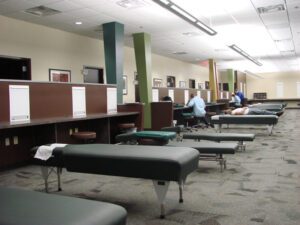Physical therapy (PT) services within a chiropractic office can be a natural complement. But what must be considered in physical therapy clinic design?
For chiropractic clinic designs that include physical therapy, the primary requirement must be the practice’s methodology. With that in mind, you can now focus on three key priorities in the design to create a more profitable therapy business and to be the most efficient you can be when treating patients.
Key Area 1: Adequate space
The initial focus is first on the requirements to provide adequate space. Typically, PT areas are big open spaces, but how much space?
As the therapist needs enough space to freely work with the patient and to easily move from one exercise to another, this total square footage is solely determined by the size and amount of equipment in the space. It is unique to each doctor and practice’s physical therapy clinic design.
Key Area 2: Begin with the equipment
To determine square footage needs, first list all your equipment and tables that take up floor space, and calculate the total square footage of floor space required. Once you have this number, multiply it by 3-4 times.
Three times works best if you will have minimum floor and exercise space, and more PT tables that can be open or surrounded by curtains. Four works better if you will need more floor space and/or you are using wall-mounted equipment that takes up minimum space itself but needs floor space for therapy. This number will give you a good starting point for how much square footage you will need to look for in a new space or carve out of existing space.
We have often found working with our doctors that many times the space they have is smaller than the equipment desired, so the tendency is to squeeze the floor space between. Unfortunately, this can hurt the practice by slowing down the efficiency of the therapy process. Ideally, you would have three feet of clear space around each side of the equipment or table for the clinician to freely move within your physical therapy clinic design.
PT practices will also have private exam and consultation rooms. For our chiropractor’s offices with physical therapy as part of their care, these are typically the same rooms for both disciplines.
Key Area 3: Line of sight
Once you have the size of space identified to work with, you can begin to lay out the equipment to correspond to the flow of treatment. The second key design element here is the “line of sight.”
Line of sight is critical for most clinics in their layout. If a PT area plans to have multiple patients working in the space, the clinician(s) responsible must have a clear line of sight to monitor all activities in the space. For the larger practices, the ideal layout would include a workstation that can see all the therapies at once. This can be in the center, or at one end positioned looking out. If this is not possible, a window from another room is a good solution.
Bonus: Flooring options
Rubber flooring is your common gym flooring. Rubber has enough surface resistance and is hard enough to easily perform exercises and stretches without an extra floor mat. It is also soft enough to cushion falls.
Three popular flooring choices for clinics are rubber, carpet or luxury vinyl tile.
Rubber flooring is easy and not costly to clean and maintain. The longevity and durability are relative to the thickness and quality or type of installation. The price is determined by the density, thickness of the rubber and how much color is added to the black. There are options for low-priced products that are thinner or less dense rubber squares that butt or lock together that can be self-installed. This is a great way to start, understanding that the concern is the long-term durability, as the tiles are usually less dense, thus not as heavy to install, and they are thinner.
Because they do not glue down, they can move and deteriorate. The best installation for longevity is roll goods that were glued down and professionally installed. These will also be the most expensive.
Carpet with a level low pile can serve the function of cushioning falls like a rubber floor. It is the least expensive flooring, especially if you use glue-down broadloom. You could use carpet tiles, which would be slightly more expensive than comparable broadloom, but would have a built-in backing that adds to the cushioning. They are also replaceable, so they have a longer durability. Although it can control sound, by that same nature, carpet is not considered a sanitary clean.
Luxury vinyl tile (LVT) is used very often. It is cost-effective for the durability. It is a very cleanable solution and very durable. On the other hand, it is hard and not recommended without floor mats for exercise therapies with potential falls. It also has very little sound control. It is a good physical therapy clinic design solution for offices with a focus on PT table therapy.
Included are examples of chiropractic offices that included physical therapy as a key part of their practice. We hope these examples will provide ideas for your office.
This article was written and published for ChiroEconomics. See it here.





